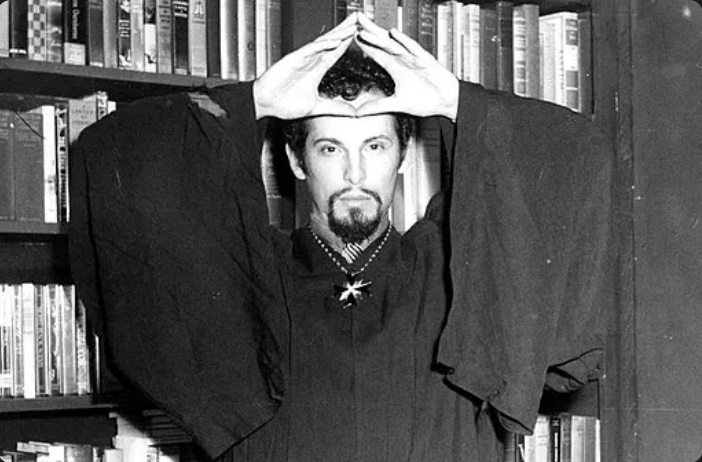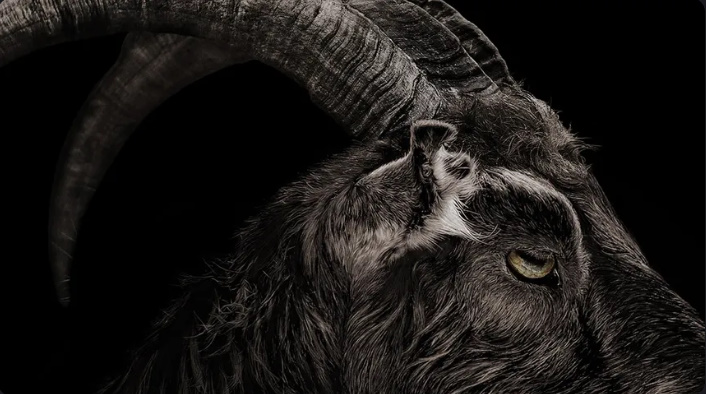
Biblical Roots of the Goat as a Symbol of Evil

There are primarily two references in the Bible from which Christians draw their ire from, as it pertains to goats.
- Yom Kippur and the Scapegoat (Leviticus 16): In the Hebrew Bible, during the Day of Atonement, two goats were used in a ritual. One was sacrificed to God, while the other, the “scapegoat” (associated with Azazel, a debated term possibly linked to a desert demon or fallen angel), had the sins of the community symbolically placed on it and was sent into the wilderness. This goat became a symbol of bearing sin, which later contributed to its negative connotations.
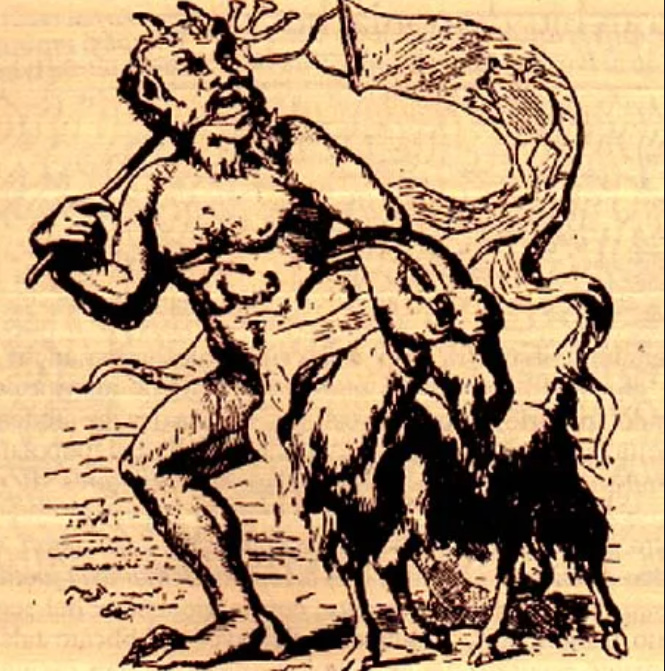
- Sheep vs. Goats (Matthew 25:31-46): In the New Testament, Jesus’ parable of the final judgment describes separating people like a shepherd separates sheep (righteous, on the right) from goats (wicked, on the left). The goats are condemned to “eternal fire prepared for the devil and his angels,” reinforcing their association with sin and divine disfavor.
Why were goats painted in such a poor light in Ancient Judea?
- Sheep: Sheep were highly valued for their wool, milk, and meat, and they were seen as docile, obedient, and dependent on the shepherd. These traits made them a natural metaphor for God’s people, who follow divine guidance (e.g., Psalm 23: “The Lord is my shepherd”).
-
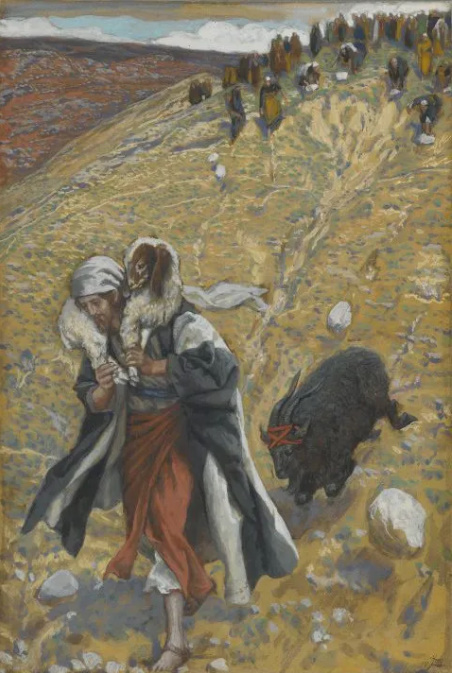
Agnus-Dei: The Scapegoat (Agnus-Dei. Le bouc émissaire), by James Tissot Goats: Goats were more independent, stubborn, and prone to wandering, traits that could be viewed negatively. They were valued for milk and meat but were less manageable than sheep, making them a less favorable symbol for obedience to God.
-
Herding Practices: Shepherds often separated sheep and goats at night because goats required more protection from cold (they are less insulated than sheep). This daily act of separation, familiar to Jesus’ audience, provided a vivid metaphor for the final judgment, where the righteous and unrighteous are divided.
-
Symbolic Convenience: The choice of goats as the negative counterpart to sheep was likely driven by their existing cultural and biblical associations with sin and independence, making them an effective contrast to the obedient sheep. The parable’s audience would have understood this symbolism intuitively.
-
Not Literal Condemnation of Goats: The passage does not suggest that goats as animals are inherently sinful; they are a metaphor. Jesus uses familiar imagery to convey a spiritual truth, not to vilify goats biologically. The focus is on human behavior, not the animals themselves.
-
Reinforcement of Duality: The sheep-goats imagery creates a stark duality (righteous vs. unrighteous, saved vs. condemned), aligning with the apocalyptic tone of Matthew 24–25, which emphasizes the urgency of living rightly before Christ’s return.
Pagan Influences and Christian Demonization
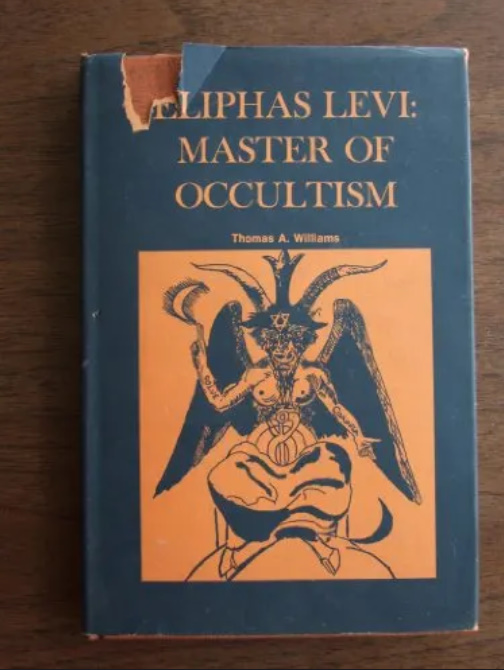
The goat’s satanic imagery was further shaped by early Christianity’s efforts to demonize pagan deities:
- Greek God Pan: Pan, the Greek god of the wild, was depicted as a half-human, half-goat satyr with horns, hooves, and a lustful nature. As Christianity spread across Europe, it often vilified pagan gods to discourage their worship. Pan’s goat-like appearance and association with indulgence, sexuality, and nature worship made him an easy target for being equated with the Christian devil. By the early Christian period, historian Eusebius of Caesarea declared Pan synonymous with Satan.
- Egyptian Goat of Mendes: The ancient Egyptian ram-god Banebdjedet, worshipped as a fertility and funerary deity, was later reinterpreted by Christians as a sinful figure. Éliphas Lévi, a 19th-century occultist, referred to Baphomet as the “Goat of Mendes,” linking it to this tradition.
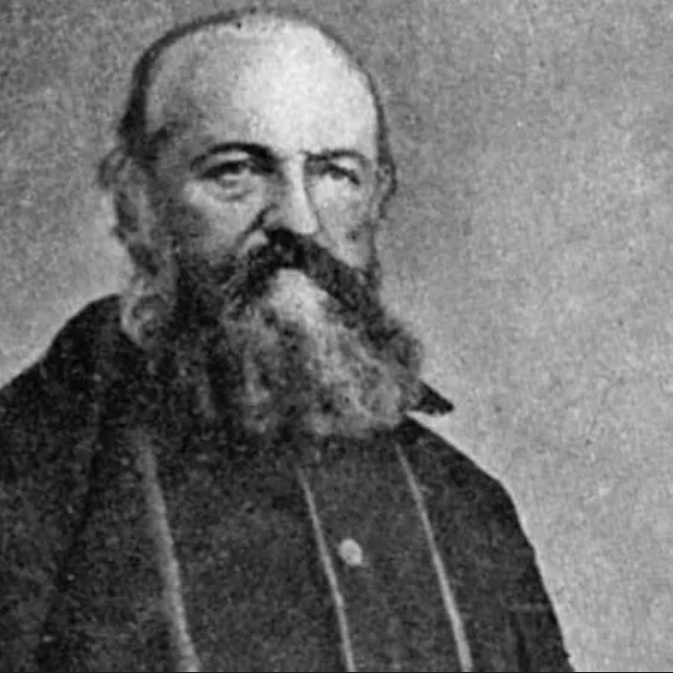
Medieval Accusations and the Knights Templar
The goat’s connection to Satanism solidified during the Middle Ages:
- Knights Templar and Baphomet (1307): During the Crusades, the Knights Templar were accused of heresy by King Philip IV of France, who claimed they worshipped a demonic idol called Baphomet, possibly a distortion of “Mahomet” (Muhammad). Under torture, some Templars confessed to worshipping a bearded, anthropomorphic figure, which later became associated with a goat-headed deity. While these accusations were likely fabricated to justify disbanding the order, they planted the idea of Baphomet as a satanic symbol.
- Witchcraft Imagery: By the 15th century, European art and literature began depicting witches’ sabbaths with goats, often portraying the devil as a goat or goat-like figure. For example, Francisco Goya’s 1820s painting Witches’ Sabbath (The Great He-Goat) shows a black goat preaching to witches, reinforcing this imagery. Goats were also linked to witchcraft through depictions of witches riding goats backward, symbolizing inversion of Christian norms.
Symbolism of Éliphas Lévi’s Baphomet
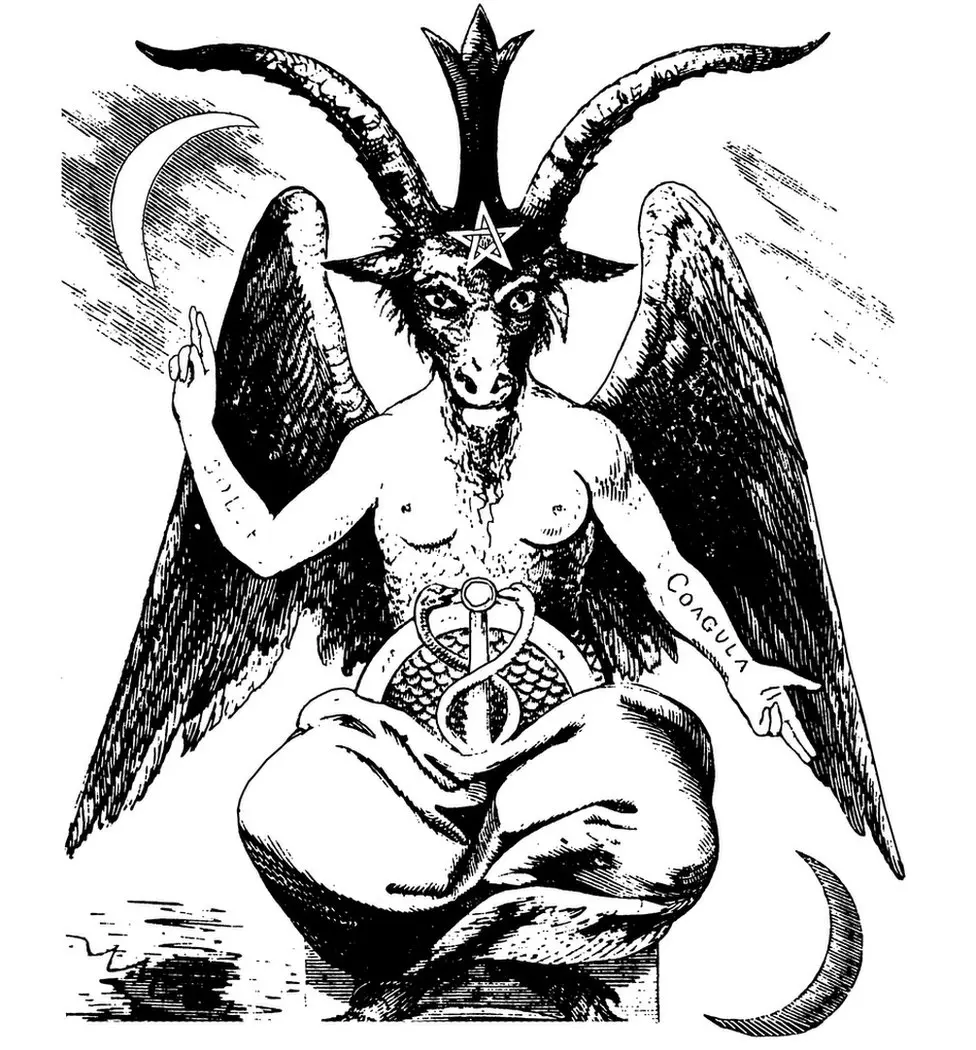
Decoding the symbolic elements of Éliphas Lévi’s 1856 Baphomet illustration; its esoteric and alchemical meanings:
-
Goat Head: – Represents the astrological sign of Capricorn, associated with ambition, discipline, and earthy materiality. In occultism, it symbolizes the primal, instinctual nature of humanity, balanced by spiritual aspiration. The goat also evokes the biblical scapegoat (Leviticus 16), bearing the weight of human sins, and connects to the Greek god Pan, symbolizing nature and fertility.
-
Pentagram on Forehead: – An upright pentagram, symbolizing spirit ruling over the four elements (earth, air, fire, water). It signifies human intelligence, divine order, and the microcosm (humanity) reflecting the macrocosm (universe). Its placement on the forehead emphasizes the mind’s role in achieving enlightenment.
-
Horns: – Symbolize power, virility, and spiritual authority. In occult traditions, horns represent the ability to penetrate or ascend toward higher truths, as well as connection to lunar and solar energies (duality). They also evoke ancient deities like Pan or Cernunnos, embodying raw, natural forces.
-
Androgynous Features (Breasts and Phallus): – The figure’s dual gender (female breasts and a caduceus-like phallus) represents the union of opposites—masculine and feminine, active and passive. In alchemy, this androgyny symbolizes the Rebis, the perfected being that reconciles all dualities, essential for spiritual transformation and the Great Work.
-
Wings: – Indicate spiritual elevation and transcendence. Wings symbolize the soul’s ability to rise above the material world, aligning with Hermetic principles of ascending from the mundane to the divine. They also suggest freedom and the airy element, balancing the earthy goat symbolism.
-
Torch Between Horns: – Represents divine illumination, intellect, and the spark of enlightenment. The flame signifies the light of knowledge dispelling ignorance, a core occult theme. Its placement between the horns suggests the balance of intellect and instinct, guided by higher wisdom.
-
Right Hand Pointing Up (White Moon): – The right hand, pointing upward with two fingers, symbolizes aspiration toward the divine, mercy, and the spiritual realm. The white moon crescent associated with it represents purity, receptivity, and the feminine principle, aligning with the Sephirothic pillar of mercy in Kabbalah.
-
Left Hand Pointing Down (Black Moon): – The left hand, pointing downward with two fingers, symbolizes grounding in the material world, severity, and earthly concerns. The black moon crescent represents mystery, the subconscious, and the masculine principle, aligning with the Sephirothic pillar of severity. Together, the hands reflect the Hermetic axiom “As above, so below.”
-
Caduceus (Phallic Symbol): – Positioned at the groin, the caduceus (a staff with intertwined serpents) symbolizes fertility, life force, and the balance of opposites (solar and lunar energies). In alchemy, it represents the kundalini energy or the rising of spiritual power through the spine, uniting body and soul.
-
Scales on Chest: – Symbolize justice, equilibrium, and the weighing of truth. In occultism, scales reflect the need for balance between opposing forces (e.g., good and evil, light and dark) to achieve harmony. They also evoke the Egyptian goddess Maat, whose scales weigh the soul’s truth.
-
Inscription “SOLVE” and “COAGULA” on Arms: – “Solve” (on the right arm) means “dissolve” and “Coagula” (on the left arm) means “coagulate,” key alchemical processes. They represent the breaking down and reintegration of matter or the self, symbolizing transformation through destruction and reformation, a central occult principle for achieving enlightenment.
-
Black and White Lotuses: – The figure sits on a globe flanked by black and white lotuses, symbolizing purity, spiritual unfolding, and the duality of existence. The black lotus represents the material or hidden, while the white lotus signifies the spiritual or revealed, reinforcing the theme of balance.
-
Globe Beneath Figure: – The globe represents the material world or the universe, over which Baphomet presides as a symbol of mastery over earthly and cosmic forces. It underscores the figure’s role as a mediator between the mundane and the divine.
-
Cloven Hooves: – Symbolize the earthy, instinctual nature and connection to the material plane. Cloven hooves, associated with goats and satyrs, evoke stability on uneven terrain, representing the ability to navigate life’s challenges while remaining grounded.
-
Overall Androgynous Posture: – The seated, balanced posture of Baphomet, with one hand up and one down, reflects the synthesis of all dualities (spiritual/material, male/female, light/dark). It embodies the occult ideal of unity and the reconciliation of opposites, central to Hermeticism, Kabbalah, and alchemy.
Although Levi’s Baphomet has recently been adopted as a Satanic symbol it truly has nothing to do with Satanism. Try convincing Christians of this though. It is an artistic symbol representing alchemical principals, and nothing more.
Modern Satanism, Goats, and Pop Culture
In the 20th century, the goat became a central symbol in organized Satanism and popular media:
- Church of Satan (1966): Anton LaVey, founder of the Church of Satan, adopted the Sigil of Baphomet as the organization’s official emblem, cementing the goat’s association with Satanism. The Church used Baphomet to represent carnality, rebellion, and earthly principles, aligning with their atheistic, individualistic philosophy. The sigil appeared on The Satanic Bible and became wid
- Satanic Temple (2014): The Satanic Temple commissioned a 9-foot Baphomet statue, unveiled in 2015, to advocate for separation of church and state. The statue, depicting a goat-headed figure with children, sparked controversy but reinforced Baphomet’s role as a symbol of rationalism and defiance against religious dominance.
- Pop Culture: Goats as satanic symbols permeated music, film, and art. Heavy metal bands like Slayer and Coven used goat imagery, while films like The Witch (2015) featured Black Phillip, a goat embodying the devil. The “Sign of the Horns” gesture, linked to goats, became a rock and roll staple, popularized by Ronnie James Dio.
Cultural and Symbolic Factors
Several factors explain why goats, specifically, became associated with Satanism:
-

Eliphas Levi Behavior: Goats are stubborn, independent, and mischievous, traits metaphorically aligned with Satan’s rebellion against God. Their horizontal pupils and cloven hooves also evoke an unsettling, otherworldly quality.
- Inversion: The inverted pentagram, often containing a goat’s head, symbolizes matter over spirit, contrasting with Christian ideals of spiritual elevation. This inversion aligns with Satanism’s embrace of earthly desires.
- Historical Scapegoating: Goats have long been used as scapegoats for human sins, from Leviticus to modern satanic imagery, making them a natural fit for representing defiance or evil.
Conclusion
The goat’s association with Satanism emerged from a confluence of biblical scapegoat rituals, the demonization of pagan gods like Pan, medieval accusations against groups like the Knights Templar, and the 19th-century occult revival led by figures like Éliphas Lévi. The Church of Satan and modern media further entrenched the goat—particularly Baphomet—as a symbol of rebellion, sin, and satanic philosophy. Despite this, some occult traditions view Baphomet as a symbol of balance rather than evil, and goats themselves remain benign animals unfairly burdened by centuries of symbolic baggage.
Riding The Goat
The phrase “riding the goat” is often associated with fraternal organizations, particularly Freemasonry, and has been historically misunderstood as a supposed ritual linked to Satanism or occult practices. However, its origins and meanings are more complex, rooted in Masonic lore, folklore, and anti-Masonic propaganda rather than actual satanic rituals.
Origins in Freemasonry
-
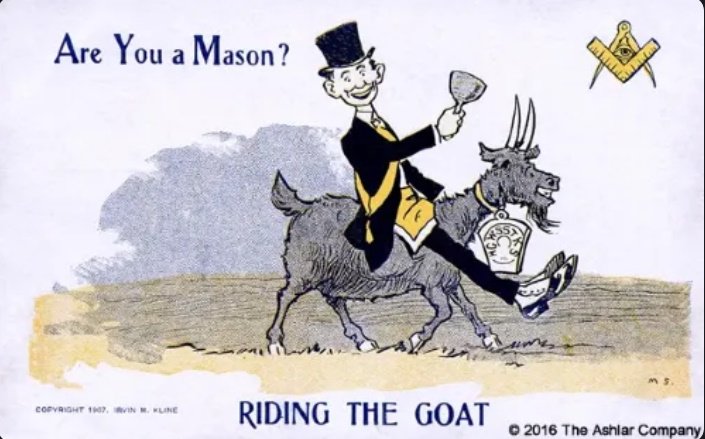 Masonic Context: The idea of “riding the goat” is a piece of folklore tied to Freemasonry, a fraternal organization with roots in the 17th century. It refers to a humorous or exaggerated notion that Masonic initiation ceremonies involve a ritual where candidates ride a goat, often as a test of courage or to symbolize some esoteric meaning.
Masonic Context: The idea of “riding the goat” is a piece of folklore tied to Freemasonry, a fraternal organization with roots in the 17th century. It refers to a humorous or exaggerated notion that Masonic initiation ceremonies involve a ritual where candidates ride a goat, often as a test of courage or to symbolize some esoteric meaning. - No Actual Goat: There is no evidence in Masonic rituals, as documented in their official ceremonies (e.g., the Blue Lodge degrees), that candidates physically ride a goat. The phrase likely emerged as a joke or a way to mystify outsiders about the secretive nature of Masonic initiations. Masonic rituals involve symbolic acts, such as blindfolds (hoodwinks) and symbolic journeys, but goats are not part of them.
The “Riding the Goat” Myth in Practice
-
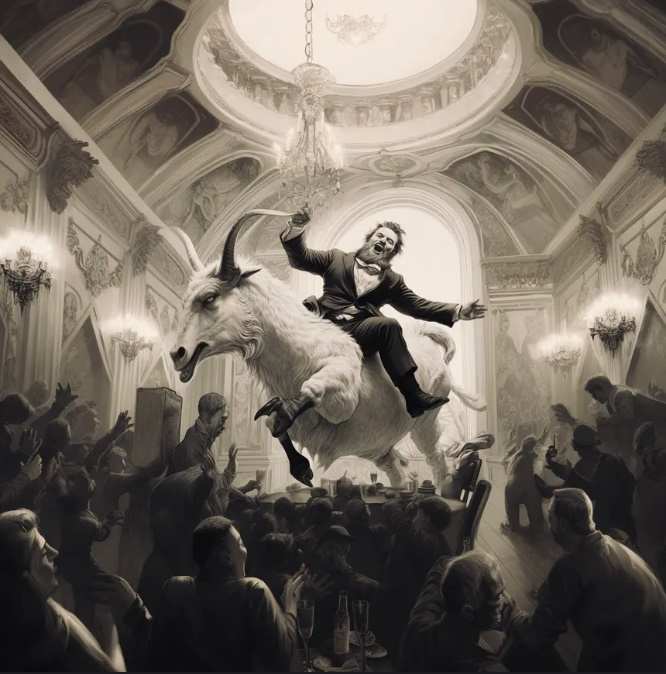
The concept of “riding the goat” in Masonic lore refers to a symbolic ordeal that initiates might face during their initiation rituals. This ordeal is not meant to be taken literally; instead, it’s a metaphorical representation of facing one’s fears, overcoming obstacles, and demonstrating one’s commitment to the values and principles of Freemasonry. Masonic Humor: By the 19th century, the phrase became a running joke among Masons. Lodge members might tease initiates about “riding the goat” to heighten anticipation or nervousness before ceremonies. Postcards and illustrations from the era depict candidates blindfolded, riding a mechanical or stuffed goat, as a humorous exaggeration of initiation.
- Fraternal Paraphernalia: Some Masonic lodges or related groups (e.g., the Shriners) used goat imagery in regalia or as mascots, further embedding the joke. For example, the Benevolent and Protective Order of Elks, another fraternal group, sometimes referenced goats in initiation pranks.
- Symbolic Interpretation: If the goat had any symbolic role, it might have alluded to the biblical scapegoat, representing the candidate’s shedding of worldly sins to enter the lodge’s moral framework. However, this is speculative and not explicitly documented in Masonic ritual texts.
Connection to Satanism
The link between “riding the goat” and Satanism is largely a product of misinterpretation, Christian anxieties, and the goat’s existing association with the demonic:
- Goats and Satan: As outlined in the previous response, goats became symbols of Satan due to biblical scapegoat rituals, the demonization of pagan gods like Pan, and the 19th-century occult figure of Baphomet. This made any mention of goats in secretive rituals suspicious to critics.
- Anti-Masonic Accusations: In the 19th century, anti-Masonic writers, such as Léo Taxil in his hoax Les Mystères de la Franc-Maçonnerie (1880s), falsely claimed that Freemasonry involved devil worship and rituals with goats, including riding them to honor Baphomet. Taxil’s works, later admitted to be fabrications, influenced public perceptions and tied the “riding the goat” myth to Satanism.
- Witchcraft Imagery: Medieval and early modern depictions of witches’ sabbaths sometimes included witches riding goats backward to mock Christian norms, as seen in art like Goya’s Witches’ Sabbath (1820s). This imagery may have been conflated with Masonic goat-riding rumors, reinforcing satanic associations.
- Cultural Misunderstandings: The secrecy of Masonic rituals and the goat’s satanic symbolism in Christian contexts led some to assume that “riding the goat” was a literal or symbolic act of devil worship, despite no evidence.
Debunking a Modern-Day Myth
Perusing the internet these days you’ll find a litany of of people pointing out that the image of the goat is used for Satanic worship because the head of the goat resembles that of the female reproductive organs… AND IT DOES. This recognition is pointed out primarily on Right-Wing Christian social media accounts, usually attempting to point out the coming of Lucifer, Satan, or the Devil and all the evil things he is about to do to the BELIEVERS.
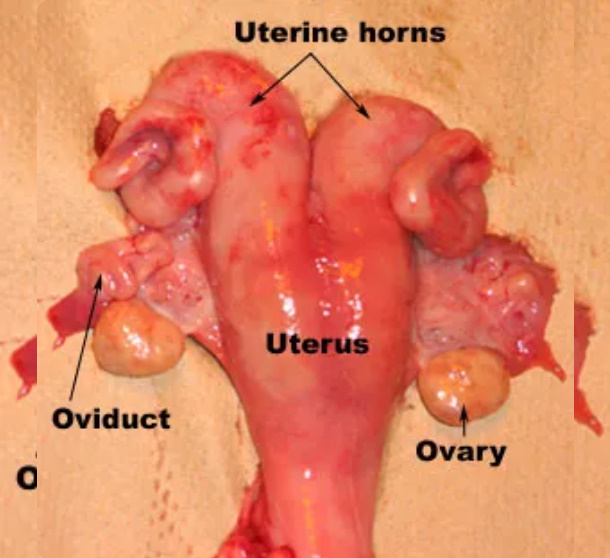
HOWEVER. This is a NEW finding/interpretation. There is exactly zero evidence that any of our ancestors chose to utilize the goat as a symbol of fertility because it symbolized the female reproductive organs. Does it fit? Sure, and it’s kind of cool that it does, but why do I make a point to reference this here?
Because Christians are Obsessed with Sex, Guilt, & Persecution!
To all you Christians out there – Please be nice to Goats, and try and relax.
